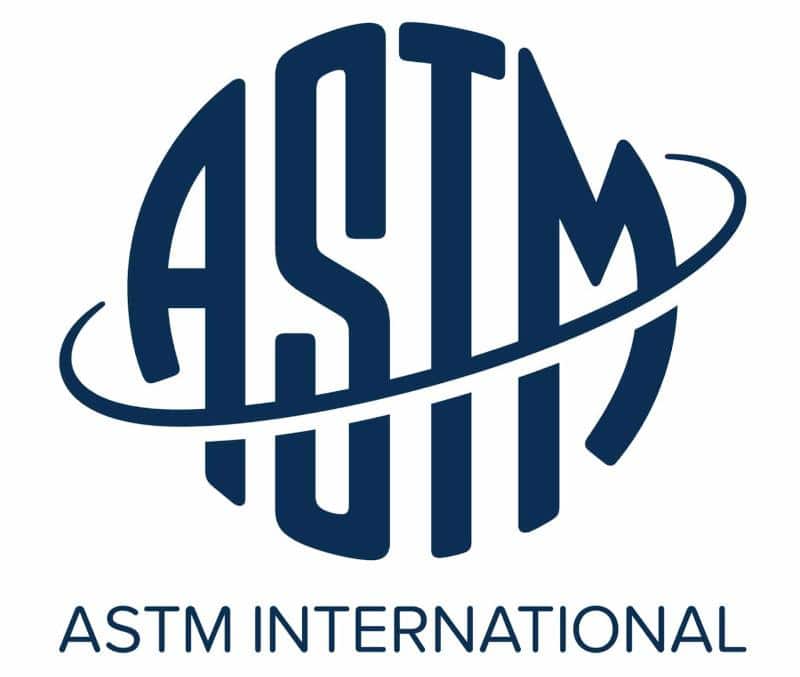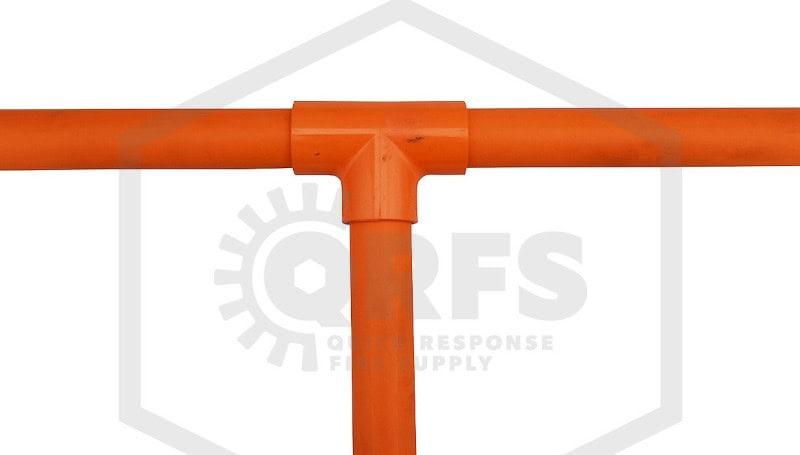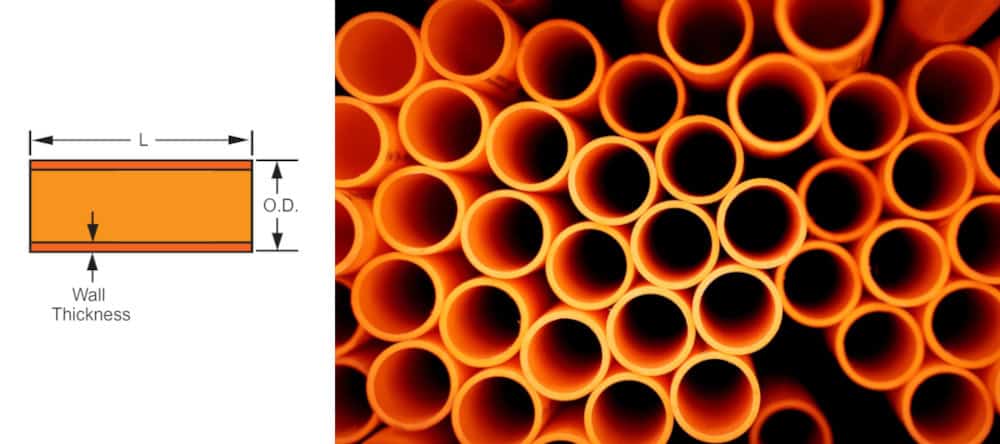Metallic and fire-rated plastic pipes use different conventions for wall thickness
Fire-rated CPVC pipe offers significant benefits for fire protection systems. For sprinkler fitters, it’s lighter and easier to cut and join than metallic pipe. It’s also far less susceptible to corrosion, and CPVC is smoother—a benefit to sprinkler system designers who need to minimize pressure loss due to friction. However, the SDR pipe units used to measure CPVC fire sprinkler pipe can be confusing if you’re not used to working with it.
To get the right size, you must specify outer diameter and wall thickness. Nominal pipe size (NPS) gives the outer diameter, and all pipes use this system. For metallic pipes and many types of plastic pipes, the schedule system determines wall thickness.
But if you shop for fire-rated CPVC pipes, you won’t see them measured in schedule. Instead, this thermoplastic pipe wall thickness is described with something called standard dimension ratio, aka SDR (although CPVC fittings are still measured in schedule units).
What’s with this difference? Read on for:
- Detailed explanations of NPS, schedule, and SDR measurements
- Why CPVC pipe for fire protection is SDR=13.5
QRFS has the CPVC pipe and fittings you need for your next system installation—all UL-listed for fire service. Check out our selection today!
Understanding NPS, schedule, and SDR pipe
To get the right-sized pipes from a supplier, people need to specify two dimensions: outer diameter and wall thickness. Both dimensions are also necessary for calculating a pipe’s internal diameter, which is essential in hydraulic calculation formulas for sprinkler system design. As mentioned, there are two different conventions for these numbers. Here’s how they work.
Nominal pipe size and schedule are the standard combo for metallic and some plastic pipes
Most pipes use nominal pipe size, or NPS (not to be confused with National Pipe Straight threads), to describe their outer diameter. NPS is measured in inches but is a nominal size, meaning that a 3-inch NPS pipe doesn’t actually have an outer diameter of 3 inches; the outer diameter is a little larger. The European equivalent, measured in millimeters, is DN (diamètre nominal, or nominal diameter).
Pipe schedule is a system used to specify the wall thickness of a pipe. The larger the schedule number, the thicker the walls. Only a few sizes of pipe schedule are used for fire protection pipe. NFPA 13: Standard for the Installation of Sprinkler Systems (2022 edition) mentions schedules 5, 10, 30, and 40. Besides being a nominal unit, the actual thickness of pipe walls varies based on NPS and schedule. For example, a 1-inch NPS schedule 40 pipe is less than but close to the same wall thickness as a 4-inch NPS schedule 40 pipe.
For reference, here are some common NPS and pipe schedule dimensions, with data sourced from Engineers Edge and Engineering Toolbox:

SDR pipe is another system for describing wall thickness
Like other pipes, the outer diameter of fire-rated CPVC is also measured in NPS units. But instead of pipe schedule, plastic pipes used in fire protection use a system called Standard Dimension Ratio (SDR) to measure wall thickness.
NFPA 13 requires all fire-rated CPVC to conform to ASTM F442: Standard Specification for Chlorinated Poly(Vinyl Chloride) (CPVC) Plastic Pipe (SDR–PR), published by the technical standards organization ASTM International. ASTM F442 uses SDR rather than schedule for wall thickness, so fire-rated CPVC does, too. (Interestingly, ASTM F441 for non-fire-rated CPVC uses schedule, not SDR.)
Rather than measuring wall thickness directly, SDR pipe measurements indicate the wall thickness relative to pipe size. The formula for this is:
- SDR=D/S, where:
- D is the actual outside diameter of the pipe
- S is the actual wall thickness of the pipe
If SDR is high, then the pipe wall is relatively thin compared to the size of the pipe. A lower SDR indicates a relatively thick, strong pipe wall. SDR pipes come in a range of discrete values: 11, 13.5, 17, 21, 26, and 32.5 are standard sizes. Pipes that use a dimension ratio outside these standard values are not “SDR” but “DR,” simply standing for the dimension ratio. For pipe using SDR, you need to specify both the NPS outer diameter and SDR to get the correct size.
It’s important to note that CPVC fittings for fire protection (tees, elbows, joints, etc.) are not measured in SDR but rather in schedule. Fittings up to 1-1/4 in. come in Schedule 40 thickness (per ASTM F438), and fittings between 1-1/2 in. and 3 in. are Schedule 80 (per ASTM F439).

CPVC fire sprinkler pipe has an SDR of 13.5
When used in fire protection, CPVC pipes meet higher standards than regular CPVC pipes and more specific standards than metal pipes. Metallic pipe, as long as it conforms to ASTM standards, doesn’t have to be listed or approved for fire sprinkler use and can be used across all occupancy types.
However, because of concerns about plastic pipe walls melting and failing, CPVC pipe must be tested for suitability in fire sprinklers and carry a listing, such as a UL mark indicating compliance with UL 1821: ANSI/CAN/UL Standard for Thermoplastic Sprinkler Pipe and Fittings for Fire Protection Service. And even with the proper listing, CPVC fire sprinkler pipe is mostly restricted to light-hazard and residential occupancies.
Part of the stringent requirements for CPVC is wall thickness. CPVC pipe used for fire protection is always SDR=13.5.
Metallic pipes can have (close to, but not exactly) the same wall thickness (often Schedule 40) across a range of NPS sizes. However, because fire sprinkler CPVC pipe has a constant SDR (recall, a ratio of diameter to wall thickness), wall thickness increases with pipe size. This is because ASTM F442 requires the pressure rating to be uniform across all pipe sizes of the same material. In this case, all SDR 13.5 CPVC has a burst pressure of 1,000 PSI at room temperature. This also means that CPVC pipes always have thicker walls than metallic pipes.

Always get listed and approved CPVC fire sprinkler pipe and fittings!
Though it’s not permitted in every setting, thermoplastic pipe such as CPVC is a great choice for fire sprinkler systems. It’s lightweight, flexible, and easy to cut and join. The only disadvantages are the need to mind chemical incompatibilities and store CPVC pipes properly.
Not just any plastic pipe is allowed in fire protection—it needs to be listed. For CPVC, that means it should be manufactured according to ASTM F442 and meet the testing requirements of UL 1821.
One consequence of these standards is that fire-rated CPVC pipe uses Standard Dimension Ratio units for pipe wall thickness (and is always SDR 13.5). This contrasts with metallic pipe and non-fire-rated plastic pipe, which typically uses pipe schedule. When ordering pipes for your next project, make sure to keep your units straight!
QRFS carries the UL-listed CPVC pipe and fittings you need, plus grooved fittings, black iron fittings, fire sprinklers, and more!
Contact us at 1-888-361-6662 or support@qrfs.com for questions or special orders.
This blog was originally posted at blog.qrfs.com. If this article helped you, check us out at Facebook.com/QuickResponseFireSupply or on Twitter @QuickResponseFS.


